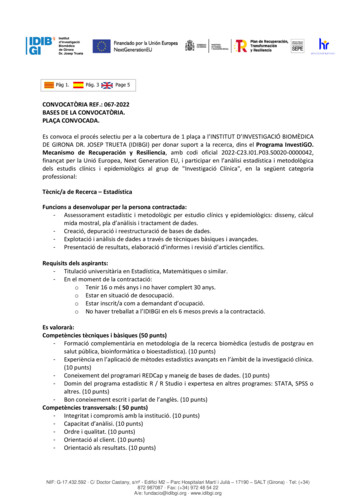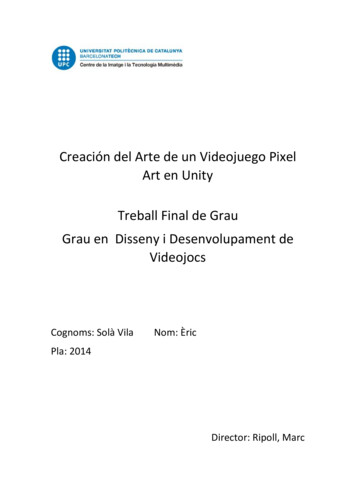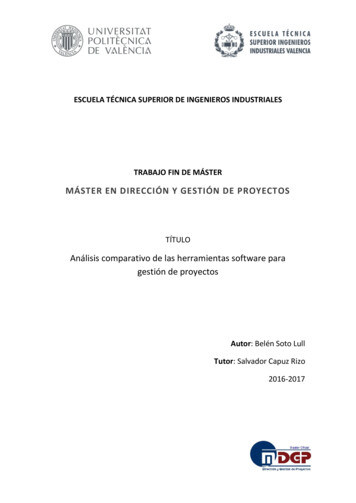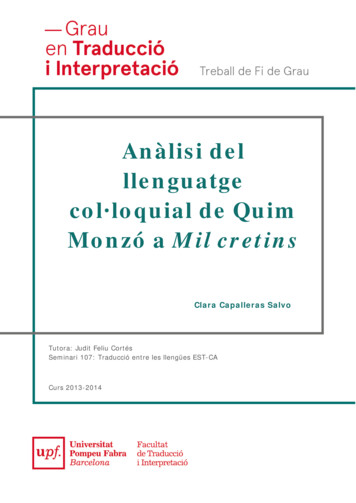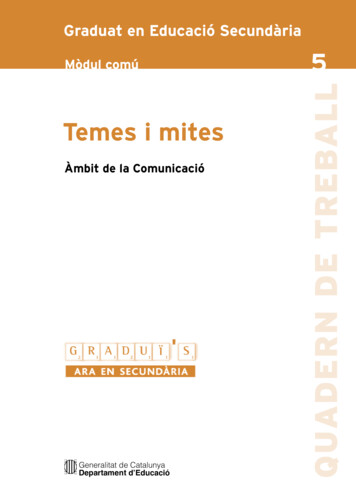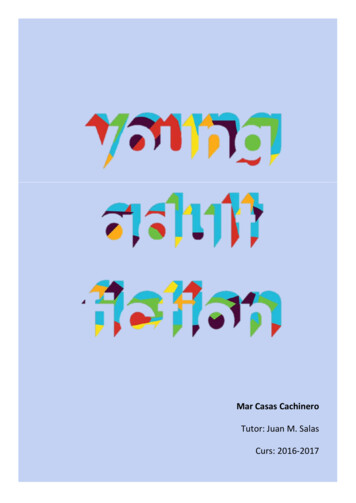
Transcription
Mar Casas CachineroTutor: Juan M. SalasCurs: 2016-2017
INDEX1.Introduction . 12.Definition of young adult literature . 33.History . 44.5.3.1The 19th century – beginning. 43.2The mid-20th century . 43.31950s and 1960s . 53.41970s and 1980s – The golden age . 63.51990s . 73.6The second golden age – 00s. 73.7Now. 8Subgenres. 94.1Contemporary. 94.2Romance . 104.3Historical . 104.4Fantasy. 114.5Paranormal . 124.6Science Fiction/Dystopian . 124.7Mystery/Thriller . 13Book analysis . 145.1The Perks of Being a Wallflower . 14Plot . 14Themes . 165.2The Fault in Our Stars . 17Plot . 17
Themes . 195.3The Book Thief . 20Plot . 20Themes . 225.4Red Queen . 23Plot . 23Themes . 255.5The Raven Boys . 26Plot . 26Themes . 285.6The Hunger Games . 29Plot . 29Themes . 315.7We were Liars . 32Plot . 33Themes . 346.What makes a young adult fiction novel? . 367.Writing young adult fiction . 397.1Why contemporary fiction? . 397.2Creative part. 398.Conclusions . 469.Bibliography . 499.1Books . 499.2Internet. 49
Mar Casas Cachinero1. IntroductionI heard the term young adult fiction for the first time not a long time ago. It was whenI first started reading books in English and I realized most of the books I read belonged tothis genre, probably because they are addressed to people my age. To choose these booksI usually guided myself through the best-sellers lists I found on the Internet.When the time came to choose my TR topic I thought about something I liked, and Iremembered that I really like books. At first, it seemed too simple and with not manypossibilities, but I started researching and discovered that there were, in fact, so manythings about those books I read that I had never been aware of and that interested me.Firstly, I wanted to know how this literature had arrived to the importance it has now,why it is so popular and why so many people fall in love with YA books, even when they arenot young adults. In my research project, I explain in a synthesized way the evolution ofthis literature from its beginning to nowadays.Secondly, I knew there were different genres inside YA, but I didn’t know there wereso many, even more than the 7 ones I’ve studied on my project. As you’ll read, the genresare basically the same from adult fiction but, for me, contemporary fiction is truly thedifferential one. This is why I chose it for my writing part, which I’ll explain later.The choosing of the books to summarize and thematically analyze wasn’t easy. Mostof them I’d read at some point and had captivated me. Also, they happened to be one ofthe most successful ones, each of their genre. I chose based exactly on this, their successand influence. There are many books I would have liked to work on, but I knew I had to berealistic so I finally sticked to 7, one for genre.After reading and studying the 7 books I tried to find something that simplified themall even though the differences, and I did. This part helped me clarify my ideas about YA,which was needed for the next one, the creative part.The most ambitious part was the writing. I had to sum up everything I had learnt andtransform it into YA written by me. I had to create a main character, which had to be ateenager and a girl, and I also had to develop this change in her life. It took me a lot of time1
Mar Casas Cachineroand worrying for it to be good enough, but finally I managed to write what I think could bethe first 2 chapters of a contemporary YA novel.It was the most ambitious but also the most important. It was proof that I had actuallylearnt something with my project and one of my initial goals: having studied YA deeply, canI create something that could belong to the genre? You can answer that for yourself whenyou get to part 6. Obviously, it wasn’t only what I’d researched, it was also my personalabilities to write YA after all I’d learnt about it.Writing my whole research project in English was a challenge, but not one I was scaredabout. A challenge because I had never written something even close to this long in alanguage which is not my first, but English is not a problem for me now, partly thanks to allthe YA books I’ve read in this language. Anyway, it has been even easier than I hadexpected. Also, it would have seemed unnatural to talk about English literature in Catalan.Methodologically, my TR basically had two inputs of information: the Internet and allthe YA books I’ve read, not only the ones I’ve studied on the project. For the history andevolution part I needed the information, which wasn’t always easy to find. You’ll find thedetails in the bibliography. The subgenres part wasn’t that complicated, because I had readbooks belonging to most of them. With the analysis of the 7 books came up a lot of workand time. Finally, the writing was inspiration and a gathering of everything I had learntabout YA thanks to my project.As I say somewhere above, I didn t think this topic would bring so many things to studyand talk about. That’s why there are things I would have liked to do that I haven’t, but I’llexplain that in the conclusions. There too you’ll find a summary of all that I’ve learnt aboutYA literature and why it was a good decision to choose it as my TR topic.2
Mar Casas Cachinero2. Definition of young adult literatureYoung adult literature, often referred to as YA, are fiction books written or publishedspecifically for teenagers or young adults, between ages 12 and 18. Even so, readers andwriters define young adults as people from 15 to their early 20s, and this is always variable.The terms young adult fiction, young adult novel or juvenile novel all refer to the YAcategory.Generally, young adult books talk about problems and issues that can sound familiarto teenagers and, in some ways, affect them. The main character and the majority of thecharacters are in this same age group. Another characteristic is that the authors use asimple language, although writing styles range widely.The fact that the main separation for this type of literature is that it is written for aspecific age implies that we can find lots of different subgenres inside the genre. Thesettings of YA novels have no limits.The subgenres are usually crossed but it could be said that there is a romantic subplotin almost every story. The most important genres and also the ones that we ll work on are:contemporary, romance, historical, fantasy, science-fiction, paranormal and mystery.Despite its unique characteristics, young adult literature follows the fundamentalelements of fiction: character, plot, setting, theme and style.The term young adult literature wasn’t used regularly until at least the 1970s. Beforethat, there had been books published for teenagers, but teachers and librarians were slowto accept those as a genre. What’s more, some adult’s books were much more appealingto young adults than to adults themselves.The YA category has changed immensely through the years and will continue tochange. In the words of author and publisher Lizzie Skurnick, “It s not surprising that YA isalways dealing with transformation, whether it be realistic or supernatural. It’s the onlygenre that can always be both. It shows teen life in full chaos. And that means constantchange”.3
Mar Casas Cachinero3. HistoryHistory of young adult literature is tied to the way this age group was perceivedthrough the years. The first time that it became clear to practically everybody that theyoung were a separate group was in the 1920s, but that doesn’t mean that, long before,books within the young category hadn’t been written and, afterwards, read by teenagers.3.1 The 19th century – beginningBritish writer Sarah Trimmer was the first to make a separation between books forchildren and for young adults. In her children’s literature periodical, The Guardian ofEducation (1802), she introduced the terms “Books for Children”, for those under 14, and“Books for Young Persons”, for those between 14 and 21.After the American Civil War, the first books with teenage characters began to appear.A difference between girls and boys was established, and while among the first, theromantic romance type was more popular, the boys preferred Westerns, mysteries anddetective stories. Little Women by Louisa May Alcott, St. Almo by Augusta Jane Evans, MarkTwain’s Adventures of Huckleberry Finn and Ragged Dick by Horatio Alger were some of themost influential books of the second half of the 19th century.In the same time, teenagers also read other books that weren’t specifically for them.Some examples are Charles Dickens’ Oliver Twist and Great Expectations, The adventuresof Tom Sawyer by Mark Twain or The count of Monte Cristo by French author AlexandreDumas.3.2 The mid-20th centuryBoth teen culture and teen literature began to take shape in the 1930s. The AmericanLibrary Association (ALA) created the Young People’s Reading Roundtable and beganpublishing a list of “books for young people”. Although the list consisted only of adult titleswith teen appeal, librarians and others were beginning to see this age group as its ownentity.4
Mar Casas CachineroTeenagers were officially given their own social demographic group in World War II. In1942, the first ever book written explicitly for young adults was published. It was a romancenovel published by Maureen Daly titled Seventeenth Summer.Daly’s book was largely for girls and talked about first love. It wasone of the first to use first person narration, a technique that hascontinued to characterize YA books. The characters, Angie Morrowand Jack Duluth are two teenagers that fall in love in the summer buthave to deal with separation when it ends.This story was followed and imitated by many more teenSeventeenth Summer,by Maureen Dalyromances that were popular among girls, like Betty Cavanna’s Going on Sixteen andRosamund du Jardin’s Practically Seventeen. On the other hand, boys preferred popularsports novels. One of the most popular authors of this genre was John R. Tunis, who wroteThe Kid from Tomkinsville and All American among others.Another important YA publication was the series of books around the character ofNancy Drew, created by American author Edward Stratemeyer, which appeared for thefirst time in the 1930s. Nancy was an attractive and amazingly talented 16-year-old girl thatsolved mysteries in her free time. Stratemeyer also started publishing another book seriesfor boys, which was titled Hardy Boys.However, there were other books published between 1900 and 1950 that were readby teens, although they had not been written for them. Some of those were Treasure Islandby R. L. Stevenson, Black Beauty by Anna Sewell and J. R. R. Tolkien’s The Hobbit.3.3 1950s and 1960sIn the decade of the 1950s, the ALA created a Young Adult Services Division in librariesafter psychologists Robert Havighust and Erik Erikson defined adolescence as adevelopmental stage when identity independence takes hold. The term “young adult”didn’t come into general use until 1958.5
Mar Casas CachineroS. E. Hinton’s The Outsiders was published in 1956. It is known for being one of themost popular and best-selling YA books of all time. It changed juvenile literature completelyas it was very different from everything that had been written for teens until that moment.Hinton’s novel featured a truer and darker side of adolescent life and talked about seriousproblems, as the plot involved a killing, gangs and a robbery.The Outsiders inspired authors in the 1970s to write more maturecontemporary realistic novels. Robert Cormier’s The Chocolate Warwas published in 1974, and it is considered a true YA classic. Thiscontroversial dark novel talks about power, corruption andconformity. Other important books of the decade are Are You ThereGod? It’s Me, Margaret and Forever, both by Judy Blume, and Go AskAlice by Beatrice Sparks.Cover of the firstedition of The Outsiders.Publishers began to focus on the emerging adolescent market and so libraries andbooksellers began creating young adult section, different from children’s and adult’sliterature.3.4 1970s and 1980s – The golden ageThe 1970s to the mid-1980s are considered the golden age of young adult fiction, asnovels began talking about interests of the newly-identified adolescent market. The YAbooks published in these years tried to get closer to the teenager’s daily lives and realproblems, and introduced hard-hitting topics such as suicide, underage drinking, parentaldeath, homelessness, sex, drug use, identity and beauty.In the 1980s, the first major YA franchise was born as the SweetValley High series was published and became the first ever book ofthe genre to reach the New York Times’ paperback best-seller list.Created by Francine Paschal, the books followed the lives of twoidentical teenage twins and belonged to the genres of soap opera,romance novel or adventure-fantasy. The series has 603 booksto its name.One of the books ofthe Sweet Valley Highseries6
Mar Casas CachineroOther notable books published in the 1980s are Fallen Angels by Walter Dean Myers,The Baby-Sitters Club by Ann M. Martin and The Hero and the Crown by Robin McKinley.The horror genre also became very popular with the publication of The Goosebumps seriesin the next decade.3.5 1990sThe early 1990s was a darker time for young adult literature as fewer YA novels werebeing published. There were less teenagers due to low birth rates in the mid-1970s. Manyfeared the extinction of the genre but in the end that didn’t happen.Indeed, this hard time for YA made the books better, as authors workedharder. The genre matured and came into its own with better written,more serious and more varied books for teenagers.Books published in those years are still best-sellers today. Someexamples are The Perks of Being a Wallflower by Stephen Chbosky, theeducation classic The Giver by Lois Lowry or LJ Smith’s The VampireDiaries; The Awakening.The Giver, dystopian novelpublished in 19933.6 The second golden age – 00sA rise in youth culture in the last years of the 20th century helped YA literature comeback stronger and, with that, the first book of the Harry Potter series (Harry Potter and thePhilosopher’s Stone) was published in 1998. Although graded for children and not youngadults, J.K. Rowling’s book inspired a whole generation of fantasy series novelists.With the new millennium and the help of Harry Potter, began what is known as thesecond Golden Age of YA. Book awards were created to honor authors of the genre, suchas the Michael L. Printz Award, the Margaret A. Edwards Award or the William C. MorrisAward. And 2000 is the year the YA market really begins to make a name for itself in thepublishing industry.7
Mar Casas CachineroFirst was Stephenie Meyer’s vampire romance, Twilight, and afterit came the futuristic trilogy of The Hunger Games. Both of these storiespopularized paranormal and dystopian books that reigned in the mid tolate 2000s.But those weren’t the only genres being published. Otherimportant books were, for example, Markus Zusak’s historical novelThe Book Thief, and also lots of romance and contemporary novels,First book of theTwilight seriessuch as Looking for Alaska by John Green, The Princess Diaries by MegCabot and Sherman Alexie’s The Absolutely True Diary of a Part-Time Indian.3.7 NowNowadays we have YA books and series across all genres being published, that tackleall type of issues and explore numerous new worlds. And the category continues to expandinto other media and genres: graphic novels, light novels, mystery fiction and evensubcategories such as cyberpunk and techno-thrillers.The number of YA books published grew a 120 percentbetween 2002 and 2012. More than 30.000 YA books arepublished every year and that is an increasing number. Asurprising fact is that 62% of those books are bought by adults between 18 and 44 years,so now adults are the ones reading books for young adults and not vice versa, likehappened before.It is also important to note that more than half of the YA books published nowadaysare written by women, unlike what we see in most adult genres, where men authors forma vast majority. Young adult novels have come to be one of the most important genresinside literature these days and numerous awards addressed only to YA books prove this.There are uncountable books of the genre trending right now, but some of the bestsellers of the last 4 years are: Delirium by Lauren Oliver, The 5th wave by Rick Yancey, TheSelection series by Kiera Cass, Rainbow Rowell’s Eleanor and Park and Fangirl, Red Queenby Ava Aveyard, Cassandra Claire’s The Mortal Instruments series, the Divergent series byVeronica Roth and John Green's The Fault in our Stars and Paper Towns, for example.8
Mar Casas Cachinero4 SubgenresThe young adult category is widely large when it comes to fiction genres, and it couldbe said that it spans most of those covered by adult fiction. What distinguishes YA, though,is that, unlike adult fiction, juvenile books have teenage protagonists who deal withteenage problems, and are generally addressed to them.Having said this, it’s important to note that there’s hardly any YA book that is classifiedonly in one of the following genres, as these books talk about a wide variety of themes.Most of them are included in 2 or more. Furthermore, there are genres that are always tiedwith others, because there’s very little that separates them.4.1 ContemporaryUsually set in the recognizable modern-day world, contemporary fiction is realistic andhas contemporary characters, events and dialogue. It is written from a first-personperspective most of the times and is marked by the emotional, evocative voice of youngadult books. Contemporary is one of the most popular YA genres among adults.This kind of YA fiction can talk about topical issues, creating debate, dealing withanything from the everyday trials of modern life for teenagers. School problems, peerpressure, social media, friendship and even political matters are just some of the issuescontemporary books talk about. Contemporary is a genre that tends to overlap with others,commonly romance and comedy.Many of the books of the genre are usually more focused on the characters than onthe plot. They have a greater need for a strong voice and a more than good main character,as they lack the unexpected and impressive things other genres can offer.Some of the most important authors of this genre are John Green (Paper Towns,Looking for Alaska), Meg Cabot (The Princess Diaries) and Ally Carter (Heist Society). Otherimportant titles are The absolutely true diary of a Part-Time Indian by Sherman Alexie, ThePerks of being a Wallflower byStephenChboskyandTheSisterhood of the Travelling Pantsby Ann Brashares.9
Mar Casas Cachinero4.2 RomanceYoung adult romance is a category that has a romantic relationship as its core andmost important feature. These novels can be set either in a contemporary, past orparanormal world. That’s why romance is often a feature of other genres, such asdystopian, supernatural or contemporary.The feelings and thoughts of the main characters have a special importance inromance YA and novels are usually written in the first person point of view. In thisemotional narrative, usually the lovers face certain obstacles that prevent them from beingtogether or expressing their true feelings.The genre rose to popularity between teenagers in the 1980s, with the publication ofthe first book of the Sweet Valley High and the ones that followed and made it to The NewYork Times bestseller list.YA romance has been seeing a resurgence in the last years. Some of the authors thathave made this possible are John Green (The Fault in our Stars), Rainbow Rowell (Fangirl,Eleanor and Park) and Gayle Forman (Just One Day, If I Stay, Where She Went).Other important YA romance titles are Anna and the French Kiss by Stephanie Perkins,All the Bright Places by Jennifer Niven and I’ll Give you the Sun, by Jancy Nelson. Thedystopian novels Delirium and Matched also belong to this genre, as does the significantparanormal series Twilight.4.3 HistoricalYoung adult historical books are set in the past and written about the past. Thenarrative usually occurs in a period of some historical significance, prior to 1970 most ofthe times. They often feature hard times, such as war, social revolutions or politicalinstability.The main character is still a teenage and has teenage thoughts. In this genre, historicaldetail, accuracy and authentic atmosphere are key. Some of the most common times the10
Mar Casas Cachinerobooks are set in are World War I, World War II, Victorian Era and the Civil Rights Movementin the 1950s.Remarkable titles include Code name Verity by Elisabeth Wein, Michael L. Printz HonorBook of 2013, Markus Zusak’s The Book Thief, set in WWII, Lies we tell ourselves by RobinTalley, and Between Shades of Grey and Salt to the Sea, both by Ruta Sepetys.4.4 FantasyYoung adult fantasy is a category that revolves around magic and myths, is set in animaginary world, features supernatural elements and usually contains an adventure orquest narrative. Its protagonists are still teenagers.The most important factor is magic, and elements tend to be more mythological andfantastic than in paranormal YA for example. It is common to find dragons, gryphons,fairies, witches, wizards and three-headed dogs in these stories.The protagonists are usually on their younger teens, and so the stories have a strongcoming-of-age thematic. This translates in the main characters having to deal with strangecreatures, magic or superpowers while they discover themselves as young adults. That isthe plot in most fantasy young adult books.It could be said that the genre started with C.S. Lewis’ The Lion, The Witch and theWardrobe, but it definitely heightened with the global phenomenon that is Harry Potter.Another important title is the Percy Jackson series, focused on Greek and Roman gods. Themost important fantasy YA books nowadays are Red Queen by Victoria Aveyard, Throne ofGlass by Sarah J. Mass and An Amber in the Ashes by Sabaa Tahir.11
Mar Casas Cachinero4.5 ParanormalYoung adult paranormal revolves around magic too and features paranormalcreatures, such as vampires, werewolves, angels, demons, ghosts, mediums and telepaths.The difference is that paranormal stories are set in the real world and, when you take awaythe “magic”, everything is left as our everyday Earth.The tone of these novels tends to be dark, and world-building is similar to that of adulturban fantasy and paranormal romance. There is significant genre crossover when it comesto this category, and we can find paranormal mixed with fantasy (urban fantasy), romance,horror and mystery more commonly.The genre exploded with the Twilight series by Stephenie Meyer and all itsrepercussion, and nowadays is one of the most popular in YA literature. Some importanttitles are: The Raven Boys and Six of Crows by Maggie Stiefvater, Beautiful Creatures byKami Garcia and Cassandra Clare’s The Mortal Instruments series.4.6 Science Fiction/DystopianYoung adult science fiction is usually set in the future and its plot often focuses ontechnology and world-building. Both technology and world-building are crucial to create ascientific frame. Dystopian stories often feature a more sinister version of our own world,with young protagonists that have to overcome the oppressive system they live in.By definition, dystopias stories are set in a “perfect” world (a utopia), that turns out tobe full of corruption, social problems and inequalities. These books are meant to make acriticism to actual society by making the reader question how the future could be.The tone and mood of novels of this YA genre are dark, as the worlds of these dystopiasare characterized by degradation in values, social hierarchy, terror and oppression.Furthermore, the young protagonists have to struggle through adult dilemmas that includeloyalty, war, cruelty or the dead of loved ones.12
Mar Casas CachineroAlthough it would now be classified as a children’s book, Lois Lowry's The Giver isconsidered to have launched the dystopian genre for young readers. After that, The HungerGames series was the massive hit that started a Golden Age of dystopian novels for teens.It is now one of the most popular genres in YA.The most important YA science fiction/dystopian titles of the last years are theDelirium trilogy by Lauren Oliver, The Selection series by Kiera Cass, the Divergent series byVeronica Roth, Patrick Ness’ The Rest of us Just Live Here, The 5th Wave trilogy by RickYancey and The Maze Runner books by James Dashner.4.7 Mystery/ThrillerThe characteristics of YA crime and mystery often overlap. Both narratives usuallycenter on a crime, mostly a murder, and the authors of these books know how to createtension and suspense. YA mystery/thriller contains elements of the mystery and thrilleradult genres, but usually without some of the gruesome details.However, there are a few differences between the two genres. The main one is that,while the mystery protagonist focuses on solving the crime to uncover the identity of thevillain, the thriller protagonist tries to defeat the villain. Also, thrillers tend to be more fas
1942, the first ever book written explicitly for young adults was published. It was a romance novel published by Maureen Daly titled Seventeenth Summer. Daly's book was largely for girls and talked about first love. It was one of the first to use first person narration, a technique that has continued to characterize YA books.

